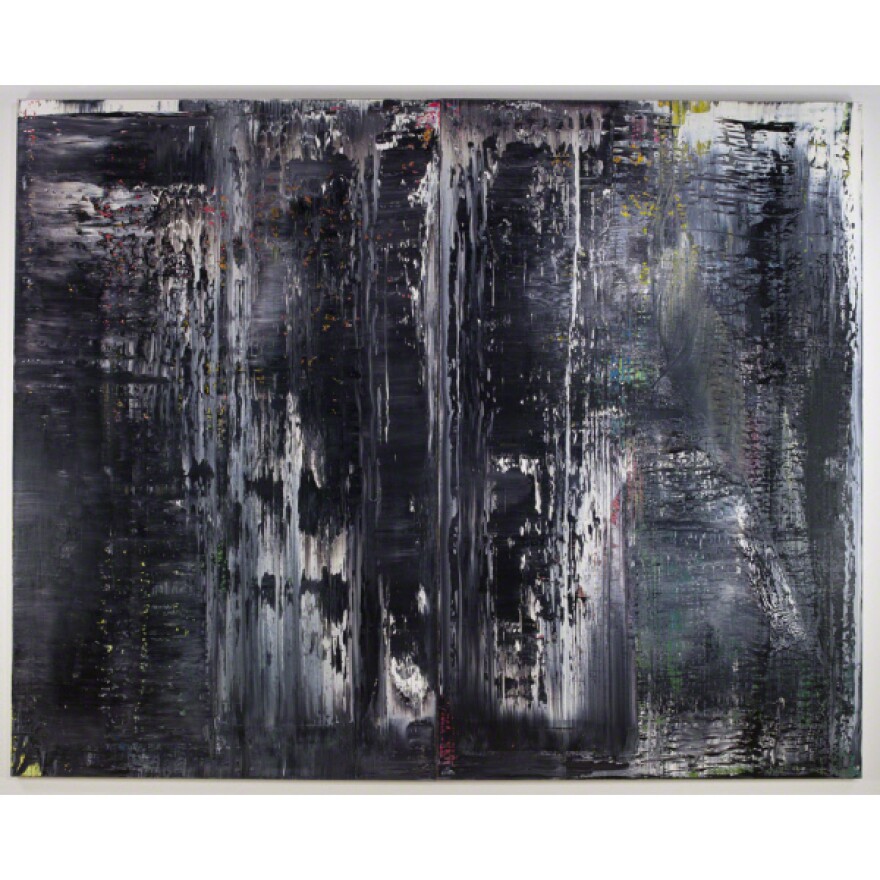This article first appeared in the St. Louis Beacon, July 15, 2013 - Entry into the special exhibit in the St. Louis Art Museum of Postwar German Art in the Collection begins with a small gallery space holding two paintings by Gerhard Richter. Cattycorner to one another are Ölberg (1986) and Betty (1988). The close placement of these two quintessentially Richter paintings – dated within two years of one another, but utterly dissimilar in style and technique – attests to the fantastically rich diversity of artistic expression that took formation in the years following WW II, encompassing the Cold War and preceding the internet.
Ölberg is a completely abstracted painting. It is massive. The brushstrokes are made not with a brush but with a spatula and other similarly indelicate equipment. Heavy uninterrupted waves of paint stripe the length of the canvas as if a superhuman with impossibly long arms created them. Richter has been quoted as saying that working in the abstract was particularly difficult for him as he was required to remove his intellectual consciousness from his painting process. This might be difficult to believe for anyone who might remain in the “a child could do that” camp of abstract critical art theory.
It is less difficult to imagine Ölberg as outside of Richter’s natural comfort zone when looking at his hyper-realistic Betty. Betty is often mistaken for a photograph. It is actually a painted portrait made from a photograph taken 10 years before Richter painted it. The painting is well-loved worldwide. It is clever because it feels like a photograph but then is so obviously a painting, because it is a portrait of the back (!) of a beguilingly beautiful head and because it is a relatively ambiguous portrait to the viewer. One may assume he or she is seeing a young woman in an elegant gown, only to find that it is actually the artist’s 11-year-old daughter wearing a sweet little-girl pajama-like outfit. Betty is painted with the love of a father to reflect his delight in life and in illusion and of clever, silly fun. No one ever said about Betty, “a child could do that.”
SLAM’s Tricia Paik and Nathan Stobaugh have aptly placed these two Richter paintings at the access point to the German postwar era exhibition. One demandingly figurative and the other boldly abstract, they provide a welcome and a gentle warning regarding the larger body of work within the galleries.
The welcome is perfectly tied to Richter’s personal story. Richter was from Dresden. His childhood wartime experience was as miserable as many of his German artist colleagues. However, he has an outsider’s perspective as a onetime East German muralist, trained in his native city of Dresden to paint happy workers for DDR government buildings. Betty is painted in Richter’s playfully entitled style of “capitalist realism,” which he described as an ironic cousin to the “socialist realism” he was taught as a student in Dresden. The capitalist element, Richter, quipped, was in that he painted subjects for their personal appeal and not for the state.
The warning: By 1960, German artists were sure of only the impossibility of surety. Most of the artwork in this exhibit is focused on deep, painful analysis, rejection and deconstruction. Richter’s Ölberg is representative (albeit brightly) of the German artistic movement to reinvent painting as a way to find relevance for a medium of expression that seemed spent out and intrinsically tied to a traumatic past.
Richter’s relationships with the other artists shown in this exhibit form one of many ways to tie the vast body of work together. Richter is closely tied to each of the other artists, through personal contact and shared exhibition history, but especially through his varied, shifting art practices that serve as exemplars of the numerous ways in which postwar artists managed to grapple with political events.
It was with Georg Baselitz, in Düsseldorf in 1981, that Richter first presented the monumental transparent mirrors that served as precedent for Gray Mirror (1991), found in this exhibition.
Postwar German artists worked to break down perceived barriers between art and life, discarding traditional pictorial language. They were interested not only in the manifestation of their art, but in exploring the political, social and commercial contexts in which their art was created and received.

In his painting, 4 Muses, Jörg Immendorff paints himself, Georg Baselitz, A.R. Penck and Markus Lüpertz all in studio settings with accoutrement that point to their varied artistic approaches and accomplishments. Immendorff’s self-conscious self-promotion provides an element of insight into the navel-gazing environment that informed these artists’ views of their role in society.
Joseph Beuys, a professor at the Düsseldorf Academy of Art throughout the postwar period, served as a mentor for the artists that form this group. Much of his personal story serves as the prequel to the movement. Immendorff’s Beuysland (1965) pays a lighthearted homage to Beuys prominence within the postwar German art scene. Beuys’ optimistic view of art as transformative is an integral component of even the darkest work in these galleries.
Richter’s greyscale landscape Townscape Sa 2 (1969) and his grim triptych January, December, November (1989) are a part of the somber grappling with events that is found again and again within these galleries. But the optimism encouraged by Beuys is there as well, in the effort to find new, genuine ways to make sense and give voice to 20th century disappoint

